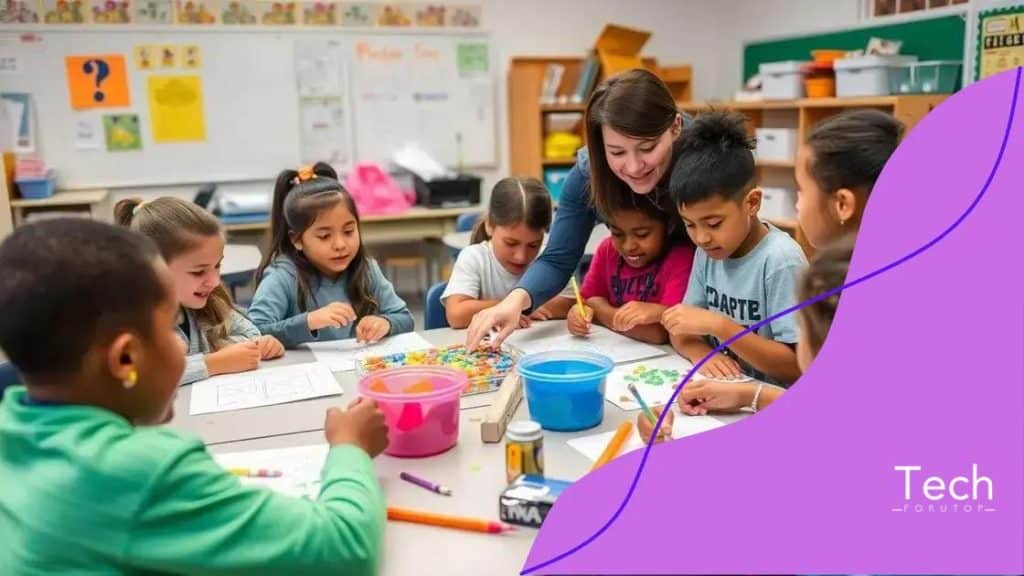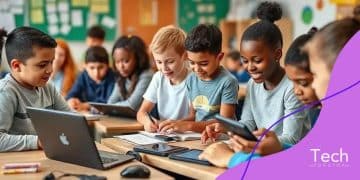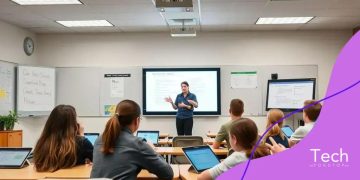Gamification in classrooms: engaging students through play

Gamification in classrooms engages students through interactive game-like elements, enhancing motivation, participation, and collaboration while improving overall learning outcomes and academic performance.
Gamification in classrooms is reshaping educational experiences by making learning interactive and fun. Have you ever wondered how games can enhance student engagement? Let’s delve into the exciting impact of play-based learning.
Understanding gamification and its principles
Understanding gamification and its principles is crucial for educators aiming to enhance student engagement. Gamification embeds game elements into learning environments, making lessons more interactive and enjoyable.
At the core, gamification leverages competition, rewards, and motivation to stimulate interest in a subject. It can transform mundane tasks into exciting challenges, encouraging students to participate actively. When students compete, they often become more invested in their learning.
Key Elements of Gamification
Here are some fundamental aspects that make gamification effective:
- Points and Rewards: Students earn points or badges for completing tasks, promoting a sense of achievement.
- Challenges: Setting up challenges keeps students motivated and encourages them to push their limits.
- Leaderboards: Sharing performance rankings incites friendly competition, fostering a communal learning environment.
Beyond points and badges, gamification emphasizes the importance of setting clear goals and providing instant feedback. Students thrive on knowing where they stand and what is expected of them. This approach helps them understand their progress and areas for improvement.
Storytelling is another vital principle of gamification. Creating a narrative around the learning experience can capture students’ attention and encourage deeper engagement. When students feel part of a story, their emotional investment increases.
As we explore gamification, it’s worth noting that simply adding game elements does not guarantee success. Effective implementation requires alignment with educational goals and a focus on student needs. Understanding the principles of gamification allows educators to adapt strategies that resonate with their unique classroom dynamics.
Benefits of gamification in student engagement
The benefits of gamification in student engagement are significant and wide-ranging. By incorporating game mechanics into learning, educators can boost motivation and interest among students, leading to better academic performance.
One of the primary advantages is that gamification makes learning more enjoyable. When students see their lessons as a game, they are more likely to participate actively. This transformation fosters a sense of enthusiasm and curiosity, which is essential for effective learning.
Enhanced Motivation
Gamification has been shown to enhance intrinsic motivation. Unlike traditional methods, where external rewards may lose their effectiveness, gamification taps into a deeper sense of accomplishment and personal satisfaction.
- Instant Feedback: Students receive immediate responses on their progress, enabling them to adjust their learning strategies.
- Personalized Learning: Gamified experiences can be tailored to different learning paces, allowing each student to thrive.
- Empowerment: By allowing students to make choices and take control of their learning, gamification builds their confidence.
In addition, gamification fosters collaboration among students. Working in teams on challenges encourages communication and teamwork, skills that are vital in the modern world. These collaborative environments let students share ideas and support each other, rising together through shared achievements.
Furthermore, the competitive aspect of gamification, such as leaderboards, motivates students to strive for improvement. When they see their progress relative to peers, it encourages them to push harder and remain engaged. This sense of competition is healthy, as it promotes productive rivalry rather than detrimental comparisons.
Overall, the impact of gamification extends beyond immediate engagement. It cultivates a culture of active learning, where students feel valued and motivated. Integrating these principles into classrooms leads to transformative educational experiences.
Practical strategies for incorporating gamification

Incorporating gamification into the classroom can transform learning experiences. Understanding practical strategies for gamification allows teachers to engage students in meaningful ways.
One effective strategy is to start small. By introducing simple game elements gradually, educators can ensure that students don’t feel overwhelmed. The implementation of a point system or badges for completing tasks can be a good starting point.
Engage with Challenges
Creating challenges or quests can also enhance engagement. Set specific objectives for students to achieve, and encourage them to challenge themselves and each other. This approach helps develop a sense of accomplishment and community.
- Set clear goals: Clearly define what students need to achieve to earn points or rewards.
- Create milestones: Break larger tasks into smaller, achievable goals to keep students motivated.
- Use game-like scenarios: Design activities that mimic game mechanics, such as missions or levels.
Another practical strategy is to incorporate storytelling into lessons. A narrative can help students connect with the material on a personal level. Using a storyline in which students can progress through levels or characters can enhance their interest in learning.
Utilizing technology can also amplify the effects of gamification. Many online tools offer gamified experiences, from quizzes to interactive modules. These tools can provide a dynamic platform for students to engage with content and collaborate with peers.
Encouraging collaboration is also key. Group activities where students work as a team can foster communication and social skills. Assign roles within teams to give everyone a sense of responsibility and participation, making the learning experience more immersive.
Regular feedback is essential in gamification. Providing immediate and constructive feedback helps students understand their progress and areas for improvement. This feedback loop keeps students motivated and focused on their learning journey.
Challenges and solutions in gamification implementation
Understanding the challenges and solutions in gamification implementation is vital for educators who want to enhance their teaching methods. While gamification can significantly improve student engagement, it also comes with obstacles that need addressing.
One common challenge is the resistance from students. Some may be skeptical about the use of games in educational settings. To overcome this, teachers can start by clearly explaining the benefits of gamification. When students see that these methods can help them learn better and have fun, they are more likely to participate.
Balancing Game Elements
Another issue is finding the right balance between gaming and educational content. If the game aspect overshadows learning, students may focus more on gameplay than acquiring knowledge. To address this, educators should ensure that the game mechanics align with learning objectives. Designing activities that blend fun with educational goals helps maintain this balance.
- Clear Learning Objectives: Identify what you want students to learn and ensure gamification enhances those objectives.
- Feedback Mechanisms: Implement regular feedback to guide students and reinforce learning.
- Adaptability: Be ready to adapt game elements based on student response and effectiveness.
Additionally, technology can pose a challenge. Not every classroom has the resources or access to advanced tools. To mitigate this, teachers can use free or low-cost platforms that allow for gamified experiences. Resources like online quizzes or simple reward systems can be effective without requiring high-end technologies.
Time constraints may also hinder the implementation of gamification. Teachers often have limited time to prepare lesson plans. A solution is to integrate gamification into existing lesson structures. Small changes, like incorporating points for participation or using interactive group activities, can easily elevate the learning experience without extensive preparation.
Finally, assessment can be tricky when using gamification. Traditional methods may not capture the true learning achieved through gamified activities. To solve this, educators can create assessments that reflect students’ engagement with the gamified content rather than standard tests. This can include project-based tasks, presentations, and peer evaluations that encourage students to showcase what they have learned innovatively.
Case studies of successful gamification in education
Case studies of successful gamification in education showcase how effective game-like elements can transform learning environments. By examining real-world examples, educators can gain insights into practical applications and outcomes.
One notable case study is from a high school that incorporated gamification into its mathematics curriculum. The school implemented a points system where students earned rewards for completing assignments and participating in class. They also introduced levels that students could achieve by mastering different math concepts. This approach not only made math more engaging but also led to improved test scores and higher overall participation.
Elementary School Reading Program
Another successful example comes from an elementary school that used gamification to enhance reading skills. They created a reading challenge where students could earn badges for completing books and participating in discussions. The challenge included a leaderboard that tracked student progress, encouraging friendly competition among classmates. As a result, many students showed a significant increase in their reading levels and a newfound love for books.
- Increased Engagement: Students were more eager to participate when they had goals to aim for.
- Collaboration: The gamified elements fostered teamwork among students, as they often worked in groups to achieve common targets.
- Parental Involvement: Parents became more engaged as they received updates about their child’s progress and achievements.
In a different setting, a university used gamification to enhance its online courses. They incorporated quizzes and interactive modules that allowed students to earn points for participation and correct answers. This method helped to create a lively learning environment even in a virtual space. Students reported feeling more motivated and engaged with the material, and completion rates for courses increased significantly.
These vibrant examples illustrate the power of gamification in education. By using game mechanics effectively, schools can foster an atmosphere where learning becomes a rewarding and enjoyable experience. Students feel encouraged to explore their subjects deeply, and educators can create memorable learning journeys.
FAQ – Frequently Asked Questions about Gamification in Education
What are the main benefits of gamification in the classroom?
Gamification enhances student engagement, improves motivation, and fosters teamwork, leading to better academic performance.
How can teachers start implementing gamification in their lessons?
Teachers can begin by integrating simple game elements, such as points and badges, into existing lesson plans to increase interaction.
What challenges might educators face when using gamification?
Challenges include student resistance, balancing game mechanics with educational goals, and integrating technology effectively.
Are there successful examples of gamification in education?
Yes, case studies show that schools and universities have successfully used gamification to boost participation and achievement in subjects like math and reading.





